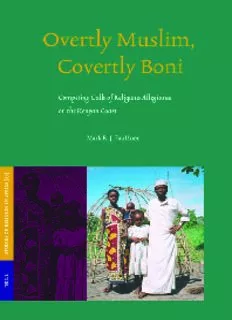
Overtly Muslim, Covertly Boni: Competing Calls of Religious Allegiance on the Kenyan Coast PDF
Preview Overtly Muslim, Covertly Boni: Competing Calls of Religious Allegiance on the Kenyan Coast
Overtly Muslim, Covertly Boni Studies of Religion in Africa Supplements to the Journal of Religion in Africa Edited by ff Paul Gi ord School of Oriental and African Studies, London Deputy Editor Ingrid Lawrie The Mirfield Centre, West Yorkshire VOLUME 29 Overtly Muslim, Covertly Boni Competing Calls of Religious Allegiance on the Kenyan Coast by Mark R.J. Faulkner BRILL LEIDEN•BOSTON 2006 Cover illustration: Ali Sani, a local diviner and healer, stands with his family in front of the house they are building on the outskirts of Bargoni village. This book is printed on acid-free paper. Library of Congress Cataloging-in-Publication data Faulkner, Mark R. J. Overtly Muslim, covertly Boni : competing calls of religious allegiance on the Kenyan coast / by Mark R. J. Faulkner. p. cm. — (Studies of religion in Africa, ISSN 0169-9814 ; v. 29) Includes bibliographical references and index. ISBN–13: 978–90–04–14753–9 ISBN–10: 90–04–14753–5 (pbk. : alk. paper) 1. Boni (African people)—Religion. 2. Kenya—Religion. 3. Somalia—Religion. 4. Islam—Kenya. 5. Islam—Somalia. I. Title. II. Series : Studies on religion in Africa ; 29. BL2480.B67F38 2006 297.089'935—dc22 2006043879 LC2675.N7P36 2005.82968'0747'1– dc2 ISSN 0169–9814 ISBN 13: 978 90 04 14753 9 ISBN 10: 90 04 14753 5 © Copyright 2006 by Koninklijke Brill NV, Leiden, The Netherlands. Koninklijke Brill NV incorporates the imprints Brill Academic Publishers, Martinus Nijhoff Publishers and VSP. All rights reserved. No part of this publication may be reproduced, translated, stored in a retrieval system, or transmitted in any form or by any means, electronic, mechanical, photocopying, recording or otherwise, without prior written permission from the publisher. Authorization to photocopy items for internal or personal use is granted by Brill provided that the appropriate fees are paid directly to The Copyright Clearance Center, 222 Rosewood Drive, Suite 910, Danvers, MA 01923, USA. Fees are subject to change. s PRINTED IN THE NETHERLAND CONTENTS List of Illustrations, Maps and Tables .................................... vii Glossary ...................................................................................... ix Preface ........................................................................................ xi Introduction ................................................................................ 1 Chapter One The Academic Framework .............................. 6 Chapter Two Bargoni ............................................................ 39 Chapter Three The Coming of Islam to Bargoni ................ 58 Chapter Four Religious Activity in the Bush ........................ 91 Chapter Five Islam in the Public Sphere in Bargoni .......... 134 Chapter Six Religious Activity at the Homestead Level .... 188 Chapter Seven Conclusion ...................................................... 248 Epilogue ...................................................................................... 259 Appendix One Documentation and Map Pertaining to Land Allocation in the Bargoni Area .................................. 261 Appendix Two Trees, Shrubs and Plants Used for Religious/Medicinal Purposes ................................................ 267 Appendix Three (a) Various Meanings Ascribed to Bao Numerology ................................................ 278 (b) Various Meanings Attached to Bao Tetragrams .......... 279 Bibliography ................................................................................ 283 Index .......................................................................................... 289 ILLUSTRATIONS, MAPS AND TABLES Photographs 1. Mzee Bobitu Kololo stands at the edge of the bush. p. 7 2. The D568 passes through Bargoni. The mosque is the white building half hidden by the mango tree. p. 45 3. A typical village scene during the El Niño rains that precipitated the horrop tree prayers. p. 92 4. The horrop tree prayers: The men assemble prior to the prayers proper. The horrop tree is to the right of the picture. p. 94 5. Home sporting a white flag to keep malevolent spirits away from the house and the baby. p. 108 6. Wedding scene: A bride’s trousseau is carried into the compound of her husband. p. 170 7. Preparing bark from the baobab (Adansonia Digitata) prior to plait- ing a divining rope. p. 192 8. Blessing the hunter: Ali Sani sits on a mat in the midst of the women. p. 198 9. Circumcision Ceremony: With the child sitting on the knee of his obaa, Mzee Habole performs the cut. p. 206 10. Making an offering at the tomomi shrub (Watheria Indica) prior to extracting the root. p. 232 11 and 12. Ali Sumoi Bwana Parua ‘thief-hunting’. Open indicates innocence, closed reveals guilt. p. 244 Maps Map 1. Bargoni in Relation to the Lamu Archipelago and the coast of East Africa. p. xiv Map 2. From Map, Dated 1992, Emanating from Lamu District, Detailing Proposed Demarcation of Land in the Area Around Bargoni. p. 266 viii list of illustrations, maps and tables Tables Table 1. Comparison of Rainfall Figures (in millimetres)—Long Term Monthly Mean for Lamu (over an 81 year period) v. Rainfall for the period June 1997 ’till May 1998. p. 41 Table 2. Bao Tetragrams. p. 218 GLOSSARY Included in this list are words appearing more than once in the text or judged to be essential for the understanding of what is taking place. The names of trees and shrubs are not listed, as they appear separately in appendix 2. buibui the black, all enveloping wrap worn by Muslim women dawa medicine dereto a (Boni) malevolent spirit duka a shop, especially of the small, village variety El Niño a weather phenomenon that caused a long and heavy rainy season on the Kenyan coast fundi an expert in a particular field haramu polluted according to Muslim dietary laws ithai Boni spirits of the bush kafir a pagan, a non-Muslim kanzu a white cassock worn by Muslim men Kimbo a brand of cooking fat kitenge a brightly coloured wrap worn by women kofia a hat, in the Bargoni context an embroidered variety orig- inating in Lamu liwali formerly a headman appointed by the government to deal with the affairs of the Islamic community mabati corrugated iron sheeting used especially as a roofing material madrasa an Islamic school where Arabic and Qur’anic instruction is dispensed makuti palm thatch used for roofing mandazi a deep fried doughnut mwalimu a teacher, both a school teacher and an Islamic teacher Mzee term of respect used to address a male elder panga a bush knife, a machete sadaka an offering safari a journey shamba a field shifta a Somali bandit sufuria an aluminium cooking pot uchawi sorcery or witchcraft
Description: